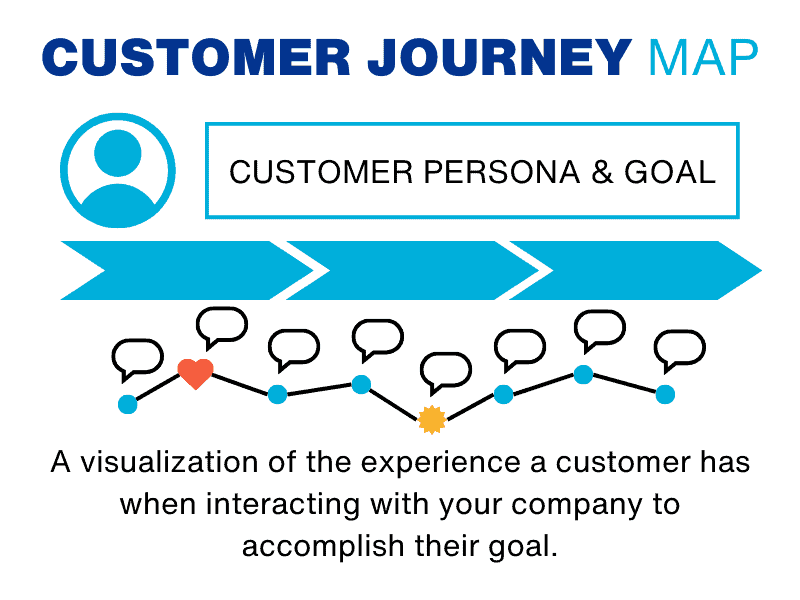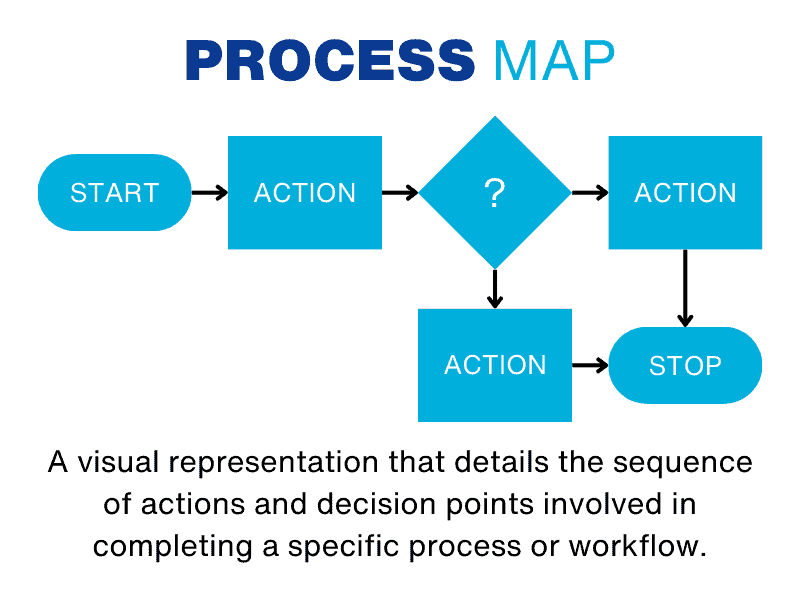What’s the difference between a customer journey map and a process map?
This question comes up when I’m journey mapping with Customer Experience (CX) leaders and we bring other departments into the project. Often, those stakeholders haven’t been exposed to journey mapping and that leads to misunderstandings.
“We’ve got three other teams in here doing process mapping,” an IT Manager told me, “I don’t know why we need you.”
The busy IT Manager was worried about committing his people to the journey mapping project because he thought we were duplicating the effort of other process improvement projects. We had to explain how customer journey mapping was different from process mapping.
Why is Mapping Important?
A map is simply a diagram that illustrates a complex interaction so everyone can understand it.
We use maps to visualize these interactions so we can align people around a common cause—to identify and pursue actions that improve business performance, like retaining more customers or operating more efficiently.
During the mapping process, we discover the truth about the interaction and communicate that insight in an accessible way.
What is a Customer Journey Map?
A customer journey map is a visualization of the experience a customer has when interacting with your company to accomplish their goal. The map shows the experience from the customer’s perspective—not the company’s.

| Perspective | Outside-In (Customer’s Perspective) |
| Visualization | Customer’s Experience |
| Elements | Customer’s Goals, Actions, Thoughts, and Emotions |
The customer journey map is a critical tool for identifying where customers are satisfied with your company, where there is effort and frustration, and what moments in that experience have the greatest impact on their loyalty—purchasing more, staying longer, and costing less to serve.
When you build your customer experience management program around the customer journey map, you can focus your limited resources to improve customer interactions that matter most to improve customer retention and create loyal customers.
See Also: 5 Must-Have Elements for Customer Journey Maps
What is a Process Map?
A process map is a visualization that details the sequence of actions and decision points involved in completing a specific process or workflow.

| Perspective | Inside-Out (Company’s Perspective) |
| Visualization | Workflows and Processes |
| Elements | Activities, Decisions, Hand-Offs, Systems |
The process map is an important tool for understanding how a business really works, and where the actual activities differ from the documentation and manuals.
When used in customer experience management, a process map can illustrate what employees and systems do to create the experience the customer is having.
For example, if an employee has to switch between two computer applications to complete a customer service request, this can create frustration in the customer’s experience when they are forced to wait on hold.
Other Types of Maps Used in Business
Besides journey maps and process maps, organizations use many other types of maps.
- Experience Maps – These are very similar to journey maps, but focus on the entire experience a customer has with your company instead of a specific journey within that experience. Where journey maps go deep, experience maps go broad.
- Touchpoint Maps – These maps focus on every point of interaction between a customer and a business. This can include digital interactions like website visits and social media engagements, as well as physical interactions such as in-store experiences or direct contact with sales or customer service representatives.
- Value Stream Maps – These are used in Lean management and focus on identifying and reducing waste in a process. They help in visualizing the flow of materials and information as a product or service moves through the value stream.
- Service Blueprints – These are detailed diagrams that show how a service is provided to customers. They typically include customer actions, points of interaction between customers and employees or systems (frontstage activities), and the internal processes that support those interactions (backstage activities). Service blueprints combine elements of both customer journey maps and process maps to show how employee actions and internal processes align with customer actions.
Secrets for Successful Mapping
Whatever kind of map you’re creating, make sure your investment in the mapping process provides value to the organization. Here are three tips for creating a successful map:
- Know the scope. It’s easy to get into a “mapping the universe” situation, where the map grows infinitely—because everything is, ultimately, connected. Before you get started, clearly define what’s “in scope” and what’s “out of scope” for the project.
- Get feedback from the people the map is about. For a customer journey map, get customer feedback. For a process map, observe and learn from the employees doing the process. Don’t rely on the opinions of management or second-hand feedback from the sales team. The quality of your map is directly related to the quality of your data.
- Keep it clear. Maps can get complex very quickly. Make sure you are showing enough detail to communicate the idea, but not so much that the audience gets overwhelmed. You may choose to summarize sub-processes and include their details on a separate map, or create an appendix for interesting information that overcomplicates the diagram.
See also: 3 Reasons Customer Journey Maps Fail
Final Thoughts
Process Maps can be created inside a company. They don’t require any non-employee input. You can bring employees into a conference room, give them sticky notes and permanent markers, and map out an internal process in a few hours.
Customer Journey Maps are more difficult because they require customer feedback, usually in the form of qualitative research. Many CX Leaders are concerned because their team doesn’t have the skills, experience, or time to conduct the customer research, and they’re worried that they only have one chance to get it right. If you’d like to jumpstart your journey mapping project, schedule a free Journey Map Review.
This post was created as part of the Vistio Knowledge Collective.
